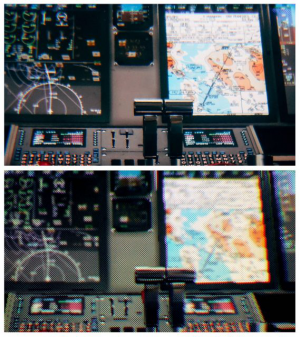Retinal resolution
Contents
Introduction
Retinal resolution, or eye-limiting resolution, is a term applied to the visual quality of a display in which above a certain threshold, the eye can’t perceive any more detail. As an example, if the human eye was a digital camera it would be capable of detecting 60 pixels per degree (ppd) at the fovea (the area of the retina with the maximum visual acuity and color discrimination). A display with pixel density above 60 ppd would essentially be wasting resolution since the eye can’t pick up more details above that number. According to Boger (2017), “if there [is] an image with 3,600 pixels (60 x 60) and that image fell on a 1° x 1° area of the fovea, a person would not be able to tell it apart from an image with 8,100 pixels (90 x 90) that fell on a 1° x 1° area of the fovea.” [1] [2]
Retinal resolution in virtual reality
Currently, the resolution of the virtual reality (VR) head-mounted displays (HMDs) is one of the biggest limitations in VR technology. This is true both for mobile VR such as Samsung’s Gear VR or a home system like the Oculus Rift. Developments in this area have been slow because VR headset companies are dependent on advances in display technology. [3]
The display resolution is critical in creating a sense of immersion in the virtual reality experience. Approaching - and eventually achieving - retinal resolution will greatly enhance the experiences that people can have in the virtual environments since vision plays a major role in immersing the user in the digital experience and therefore contributing to a sense of presence. [4]
The first development kit for the Oculus Rift HMD had a low-resolution display that caused a ‘screen door effect’ in which the pixels could be seen - a detrimental effect on the overall experience. [4]
In 2015, Michael Abrash - speaking at the Facebook Developer Conference - noted that VR HMDs would have to reach 16k resolutions to achieve retinal resolution. As an example of how much better visuals can get, he said that “in order for Crescent Bay [an Oculus Rift prototype] to deliver the same pixel density as a monitor at a normal viewing distance, it would have to have a resolution of about 5K by 5K per eye, something like 20 times as many pixels as it currently has,” he said. “In order for it to have retinal resolution at a field of view of 180 degrees, it would have to have something on the order of 16K by 16K resolution, roughly 200 times as many pixels.” [4] Indeed, achieving retinal resolution is the ultimate goal for VR HMDs. This will be a gradual process, as displays get better and closer to eye-limiting resolution and, consequently, photo-realistic experiences. [1]
Developments toward retinal resolution
In June 2017, Varjo, a company based in Finland, announced a new display technology for augmented reality (AR) and virtual reality, claiming that it is “the first human eye-resolution VR/AR/XR immersive display” and that it has an “effective resolution” that’s nearly 70 times greater than the Rift and Vive.” Recently, other companies like Samsung and Kopin have presented new VR displays with an increase in resolution when compared to the Oculus Rift and HTC Vive. [3]
Varjo’s display technology combines typical VR displays with higher density micro-displays to make part of the image sharper (Figure 1). The company states that portion of the image achieves retinal resolution by projecting a high-resolution microdisplay into the center of a lower resolution display. In practice, this is like having a very high-resolution window in the middle of the user’s field of view, with a lower resolution everywhere else. [3]
Some issues with the Varjo’s prototype have been noticed: there is a notable border separating the high-resolution and low-resolution parts of the image and not a seamless blend between the two. There are also reports of issues with a mismatching framerate. [3]
In October 2017, during CEATEC, the Pimax 8K HMD was shown. It features a resolution of 7,680 x 2,160 and a field of view of 200-degrees. The resolution is not, in fact, 8K (7,680 x 4,320) but the Chinese company Pimax argues that the “8K” in the product’s name is to highlight the higher horizontal resolution compared to other VR headsets. More accurately, each panel of the HMD has 4K (3,840 x 2,160) with 90 Hz refresh rate. [5]
References
- ↑ 1.0 1.1 Boger, Y (2017). Understanding pixel density & retinal resolution, and why it’s important for AR/VR headsets. Retrieved from https://www.roadtovr.com/understanding-pixel-density-retinal-resolution-and-why-its-important-for-vr-and-ar-headsets/
- ↑ Merriam-Webster. Fovea. Retrieved from https://www.merriam-webster.com/dictionary/fovea
- ↑ 3.0 3.1 3.2 3.3 Lang, B. (2017). Startup aims for retinal resolution VR display With 70x “effective resolution” of today’s headsets. Retrieved from https://www.roadtovr.com/startup-varjo-aims-deliver-retinal-resolution-vr-display-nearly-70x-pixel-density-todays-headsets/
- ↑ 4.0 4.1 4.2 Feltham, J. (2015). Abrash: VR needs to hit 16K to match ‘retinal resolution.’ Retrieved from https://www.vrfocus.com/2015/03/abrash-vr-needs-hit-16k-match-retinal-resolution/
- ↑ Rai, R. (2017). Chinese startup's '8K' VR headset is surprisingly advanced. Retrieved from https://www.engadget.com/2017/10/12/pimax-8k-vr-headset/
